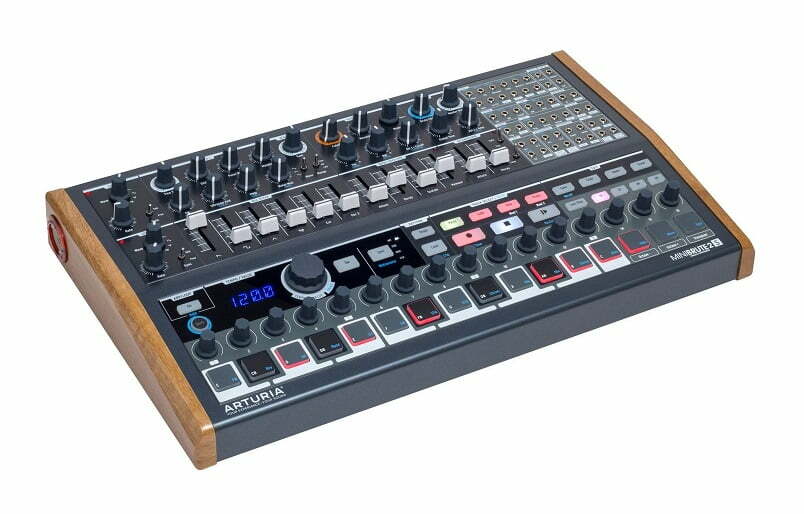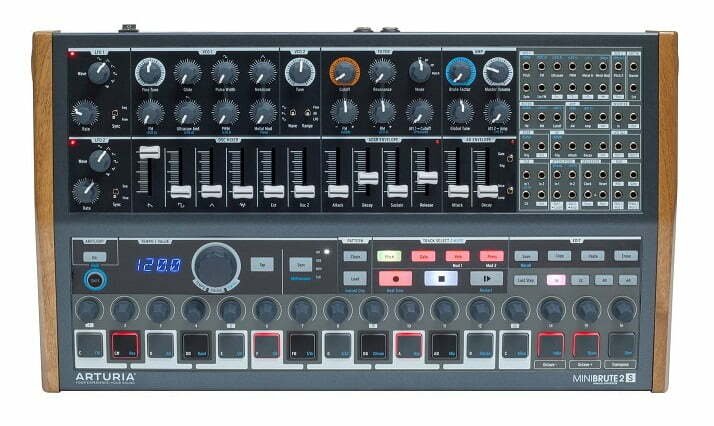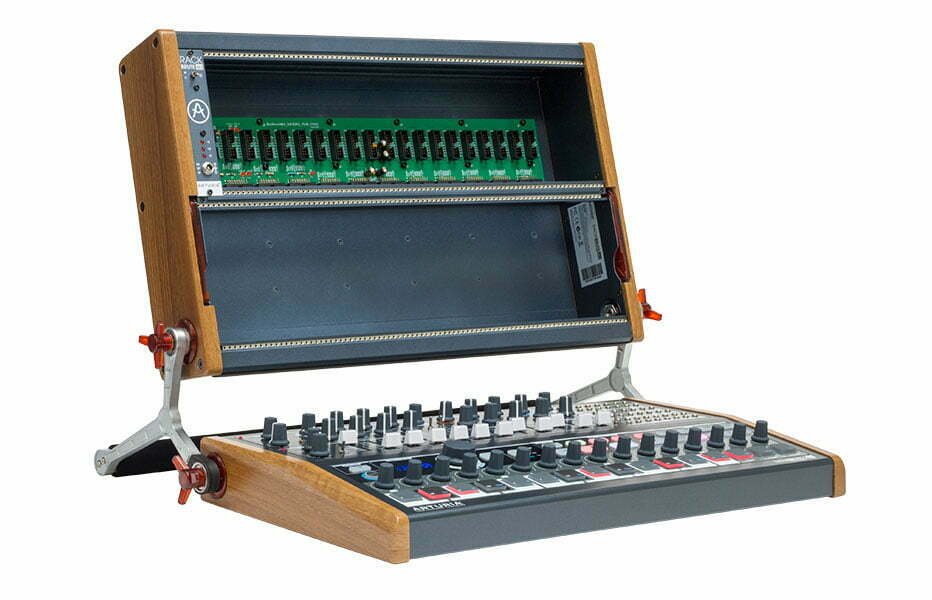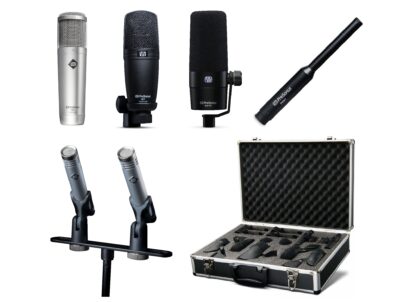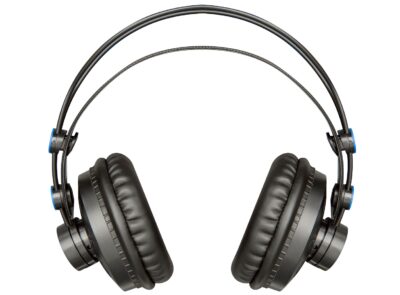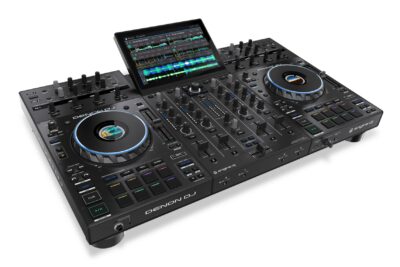Description
MiniBrute 2S
The MiniBrute was a statement. An organic, tangible breath of fresh air, a proud analog monument among the slew of sound-a-like synths that had flooded the market. Arturia’s ethos has always been to create exciting, meaningful instruments; instruments that traditional synth companies simply wouldn’t release.. If we were going to recreate a legend, the 2nd generation of MiniBrute needed to be raw, exciting, and more than a little bit scary.
Born out of necessity, MiniBrute 2S was designed to bridge the gap between the more traditional synth world and the ever-evolving modular scene. Creating a sort of ‘creative glue’ that would fuse these two creative processes together, making something new and exciting.


Meet The Oscillators
It all starts from somewhere, and the Oscillator & OSC Mixer panel on MiniBrute 2 let you create the foundations of your sound.
Since the original MiniBrute, one of the core ‘Brute’ features has been the ability mix and shape multiple waveforms to create a huge variety of sonic results. With MiniBrute 2S, now you can even mix in a second VCO as well as an external sound source. This core building block is one of this synth’s most defining features, and the ability to tweak and personalize them makes MiniBrute 2S one of the most capable, versatile synthesizers around. Each standard waveform can even be augmented with a dedicated “sound shaper” parameter, taking basic, age-old synth sounds to the next level.

- White Noise
Adding another level of creative possibilities, the white noise generator can add a little airy texture or rather a stormy buzz to a sound. A little noise here and there can give your patch depth and help push your filter. It also opens up vast synth-drum sound possibilities. - Frequency Modulation
MiniBrute 2S also gives you the ability to apply some frequency modulation to the VCO 1. By default, this can be done from VCO 2’s signal, but you can also use practically any source via the CV/Gate modulation patch bay. Create anything from subtle vibrato and tonal changes to full-blown audio chaos. - VCO 2
The 2nd VCO lets you choose between sine, saw, and square waves. Benefitting from an independent tuning setting, it will either let you add subtle harmonics to the sound, harden it through fine detuning or even create wide pitch intervals from sub-oscillation to high pitched overtones. It can even operate as a third LFO thanks to the appropriate range option. Just like the other sound sources, the level of this oscillator can be adjusted using the OSC Mixer so that you can choose freely between using it only as a sound source, only as a modulation source and anything in between. - Sawtooth & Ultrasaw
The bite of the Brute, the sawtooth is a classic, aggressive waveform with harsh elements that cut through a mix with ease, and its rich harmonic content reacts beautifully to being filtered. The related ultrasaw sound-shaper thickens up the saw wave, changing the profile of its ‘teeth’ with detuned twins of the original wave. This adds a really fat, widescreen feel to the sound, fleshing out your tone and creating an altogether different beast. The Ultrasaw Amount knob controls the amplitude of the twin waves while the related modulation source, by default LFO 2, controls their level of detuning around the initial saw. - Square & Pulse Width
Another synth standard, the square wave has a sound of extremes. Beefy, sharp, and bright at the same time, the square wave has an energetic, instantly-usable timbre. Widely used in vintage video games, MiniBrute 2S gives you the tools you need to teleport this iconic sound into the 21st century. Alter the Pulse Width to go from a square to a rectangle and even a pure pulse wave resulting in a seamless transition in the harmonic content. You can determine the pulse width both statically thanks to the Pulse width knob and in a variable way through a modulation source, the LFO 1 by default, and the related modulation amount knob. - Triangle & Metalizer
The triangle wave is generally the go-to waveform for creating softer, more subtle tones. Gentle on the ears, sounds based on the triangle have a sort of dreamy, other-worldly feel. While you’ll no doubt appreciate the softer side and sonic variety of MiniBrute 2S, we also included the Metalizer sound-shaper to ruin the triangle wave’s day. Based on the principle of wave folding, it adds shearing, harsh metallic overtones, lending itself perfectly to hot bass sounds and screaming leads.
For that extra level of control, in addition to setting a static Metalizer offset, you can let the velocity or any other modulation source control its level. Imagining the expressive depth of a soft, delicate Triangle waves evolving into raucous, powerful metallic stabs as you play harder.
Filter Freak
If the oscillators are a synth’s vocal chords, think of the filter as its mouth. MiniBrute 2S features a powerful 2-pole, 12dB Steiner-Parker filter, renowned for its acidic tone, and capable of wild auto-oscillation.
The filter can be set as part of a patch. You can cut out the low end for a bright lead or pad, mute the highs to make a bass sit nicely in the mix, or notch out mids to leave space for other melodic elements. The filter can also be dynamically tweaked and modulated, giving you a huge scope for animated, expressive sound creation.

- Cutoff & FM Controls
The filter’s cutoff is used to control the frequency of the filter’s effect, where it starts making the ‘cut’, where the magic appears, so to speak. The cutoff frequency can be set statically, thanks to the dedicated knob, as well as dynamically, by letting a modulation source impart a fluctuation. Assigned to the ADSR by default, or any other source you choose through the patch bay, including audio signals. How far and in which direction the cutoff will move around its offset value will depend on the setting of the FM knob. Furthermore, you will be able to superimpose a second source of modulation through the entry point of the Attenuator 1. Manual 100% under-control variations, slow automated sweeps or audio-to-cutoff anarchy, choose your side and change as often you want! - Filter Modes
The filter has 4 unique modes giving you an epic level of creative flexibility. Of course, it includes the standard lowpass and highpass modes you find on most filters, but also a bandpass mode, allowing some wah-wah sweeping effects, and a notch mode that brings string-inspired patches to life. Each playing their unique role, you’ll quickly consider all of them as indispensable elements of your own sonic signature. - Resonance & Modulation
The Resonance control boosts the frequencies around the Cutoff point, modifying the harmonic profile of the sound, and adding an interesting sweep effect when moving the Cutoff. It can also be pushed into auto-oscillation when raised high enough which let a sine-like wave ascend through the mix. When modulated, it can either lead to a periodic harmonic evolution, as it is the case with the natively-assigned LFO 1, or become a vector of additional expressivity for instance using the pressure or velocity as a source.
Push The Envelope
MiniBrute 2S includes not one, but two types of envelopes set to generate a modulating signal that is initiated when receiving a trigger signal, such as the gate related to a new note.
Indeed, aside from the common ADSR envelope, it also features an atypical multi-mode, AD envelope. They can be used to reproduce traditional instruments’ behaviors and in particular the natural evolution of the amplitude and timbre of the sound all along the lifespan of a played note. They can also be used to create sonic structures that only synthesis is capable of: everything from short, snappy hits to slow motion, endless waves or even frenetically-repeated jerky sound.

- ADSR
The well-known envelope filter will be familiar to every synth fan. This traditional, flexible modulation source lets you define the duration or level of different phases: the Attack, the time to reach its highest value; the Decay, how long it will be to return to the Sustain level that can be set and will be hold until the end of the trigger signal; and at last the Release, the lapse the fall to zero will take. By default, the ADSR envelope modulates the frequency of the Cutoff and it is initiated by the reception of a gate resulting from a new note but of course this will only be true until you decide to change it. - AD
You may think the AD envelope is simpler than its big sister ADSR. Yet the possibilities it offers are unique thanks to its multiple modes, creating a huge variety of sonic possibilities.- Gate + Once: pushing and holding a note engages the Attack, and holds the maximum amplitude as a sustain value. Releasing the note engages the Decay, working as a traditional ‘release’ at this point. If the note is released before it reaches its maximum position, it will immediately engage its decay from this point.
- Trig + Once: no matter if the note is held or released, playing a note engages the complete Attack / Decay cycle with no sustain in between.
- Gate + Loop: loops the attack and decay cycle as long as a gate signal is received, from a note being held, for example.
- Trig + Loop: loops continuously, whether or not a gate signal is received or not.

The LFO Lowdown
Featuring 6 selectable waveforms with rate control, and the ability to sync with its clock to add a rhythmic feel, or run free they are the ideal supplier of periodic modulations. No matter what role you assign them, they will always give you usable results.
Patch It Up
Even if the only things you connect to MiniBrute 2S are the power adapter and headphones, you’ll still be able to create out-of-this-world sounds. Every component and feature has its own dedicated assignation, set by the exceptional synth minds at Arturia. If you want to break the mold and go off the beaten track, you can start patching and creating exciting, and often surprising connections.
Your first option consists in overriding the default, internal assignments by connecting a patch cable from one of the white-highlighted sources to any destination you choose. Let’s say you want something else to control the Metalizer amount other than velocity, LFO 1 for example. Just connect the related CV connections and you’re done. Is there anything easier? Probably not, so go ahead, experiment, and find all those new connections that send shivers down your spine. There are practically limitless combinations and exciting sounds to discover, and that’s even before we start to involve external modular equipment.
Step In Line
MiniBrute 2S features a dedicated, sophisticated sequencer, with one layer for melody, and two more layers for sequencing parameter controls, all editable in real-time as you perform. MiniBrute 2S also features an arpeggiator with multiple modes, tap tempo, and rock-solid sync, so you’ll never drop the beat.

- Arpeggiator & Loop
The multi-mode arpeggiator lets you quickly create looping patterns that flow from the notes you play using the pads. The pattern can play forwards, backwards, in an alternating combination, and randomly, and at multiple time resolutions. - The Sequencer Tracks
MiniBrute 2S gives you three times the control, with three unique tracks that allow you to add more depth and control to your sequences. The first track works much as you’d expect: adding note information, and letting you build up the musical element of your sequence. This track contains pitch, gate, velocity, and pressure information. The second and third tracks are dedicated “mod” tracks that run simultaneously to the first. Track 2 overrides the velocity of track 1 and makes it independent, and track 3 does the same of track 1’s pressure value. Both of these tracks can be assigned via the modulation patch bay to control the destination of your choice. Rhythmically spread the width of your Square wave, trigger screeching LFO hits, Create an undulating harmony with VCO 2. Everything is up to you, and the possibilities are as limitless as they are exciting. - Pattern Chaining
When you create a solid sequence, you can of course save your work. Once you’ve got a collection of sequences under your belt, MiniBrute 2S lets you chain them together to create full tracks. Chain up to 16 saved sequences together, each up to 64 steps in length, in any order you like. The pattern chain loops, creating a never-ending performance cycle that’s entirely under your control. MiniBrute 2S is truly performance-focussed, hugely creative instrument. - Editing & Recording Modes
Intuitive, hands-on, and joyous, MiniBrute 2S’s sequencer features several editing and recording modes, giving you the tools you need to fully channel your creativity.- Standard editing – When you hit the Record button, using the pads will activate or deactivate the steps, the knob is used to control the track’s functions.
- Real-time recording – Hitting Shift and Record will enable real-time recording. In this mode, the pads let you perform notes and adjust the octave, while using the knob lets you change the value of the track’s main function. Holding Shift and moving the turning the knob will change the value of the track’s additional function.
- Scale editing – This lets you adjust the scale of the sequencer tracks that are set on “Pitch”, locking them to a particular scale. On top of the included scales, it’s also possible to create a custom, user-defined scale by using the Arturia MIDI Control Center.
RackBrute Compatible
The synth also incorporates the new Arturia Link system, letting you connect to an Arturia RackBrute. This adds 3U or 6U of powered Eurorack space for your modular equipment in a secure, stable housing. Not only can the system be configured in multiple positions, it can also be folded up and carried safely and securely. For extra protection, the RackBrute Travel Bag adds precious piece of mind when you need to safely transport your precious synth and modules.



